15 Roomba to Automate Large Home Cleaning in 2020

Large homes are challenging for all vacuum robots including Roomba, because of various reasons.
- First, such homes have many rooms and their total area is large. This is why the best Roomba is the one that covers the maximum area in a single cleaning cycle.
- The second important criterion to consider is the amount of required maintenance. To truly save your time, a vacuum robot should require little maintenance. It should operate autonomously for extended periods of time, all without human intervention.
- Last, but not least, best Roomba should be easy to use. In the context of large homes, this means that it should be possible to decide when and where your vacuum robot should operate.
In this article, we review 15 Roomba currently on the market. We provide you with a precise analysis of their cleaning performance, with respect to large home requirements.
A. Which Roomba Cleans the Maximum Area in One Cycle?
The maximum area covered in a single cleaning cycle is the first important criterion for choosing a vacuum robot for a large home. This is driven by the 4 following features:
We describe in the following what each of these features actually mean. Besides, we review the 15 Roomba and how good they are regarding each feature. This analysis is summarized in Table 1 below.
1. Battery Runtime
The battery runtime is the maximum amount of time during which a Roomba can operate on a single battery charge. In our selection of Roomba, we find values ranging between 1 and 2 hours.
Although 60 minutes is a decent duration for small homes, it is not enough to cover homes with multiple big rooms. Even 75 minutes of continuous cleaning is rather low.
Instead, we recommend to choose a vacuum robot which battery lasts 90 minutes or more. This case of the cheap Roomba 675, Roomba 690, and the more recent Roomba e5. But, the Roomba with the best autonomy on a single charge is no other than the high-end Roomba 980. It can run up to 120 minutes before going back to its charging station!
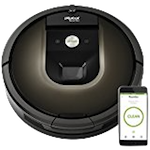 Buy Roomba 980 from Amazon
Buy Roomba 980 from Amazon 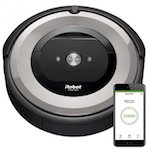 Buy Roomba e5 from Amazon
Buy Roomba e5 from Amazon 2. Systematic Navigation
To clean your condo or your house, vacuum robots have to move around. Here, the challenge is to navigate in a way to cover all the place. To do so, there are two options as shown in Figure 1 below:
- Systematic navigation (Figure 1 – left). Only 4 high-end Roomba follow this optimized navigation pattern. Indeed, Roomba 960, Roomba 980, as well as Roomba i7 and i7+ are capable to localize themselves. As a result, their behavior is more natural. That is, they do clean each place only once, much like humans with a regular vacuum.
- Random navigation (Figure 1 – right). This solution is adopted by most vacuum robots, and more specifically affordable Roomba. Basically, the robot moves forward until it reaches an obstacle. Then, it turns at a random angle, before moving away. These Roomba have no idea where they are located. So, they often end up wasting there battery cleaning the same places several times.
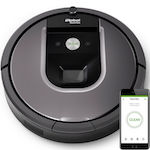 Buy Roomba 960 from Amazon
Buy Roomba 960 from Amazon  Buy Roomba 980 from Amazon
Buy Roomba 980 from Amazon 3. Recharge & Resume Cleaning
As with systematic navigation, the recharge and resume feature is only available in 4 high-end vacuum robots by iRobot, namely: Roomba 960, Roomba 980, as well as Roomba i7 and i7+. Indeed, these vacuum robots are capable of localizing themselves. So, when the battery is low, they go back to their charging station. Once their battery are fully recharged, they resume cleaning.
Video 1 below shows how a Roomba 980 successfully manages to cleans 1500 square feet (~140 square meters). Even if the 980 has the best battery autonomy in the market (120 min), it cannot clean all rooms on a single charge. However, this Roomba is smart enough to recharge and resume cleaning to ensure the job is fully done!
Video 1. Roomba 980 Recharges & Resumes Cleaning
 Buy Roomba 980 from Amazon
Buy Roomba 980 from Amazon 4. Persistent Maps
To understand this feature, you should first know that Roomba with systematic navigation do rely on a map. Actually, they spend a fraction of their time visiting different areas of your home to build the map. While they do suck dirt that they might find in the way, most of the cleaning is done afterwards.
Among the 15 Roomba we have reviewed, Roomba i7 and i7+ are the 2 only Roomba to provide persistent maps. By saving the map into their onboard memory, the i7 and i7+ do speed up the cleaning a little bit. Indeed, they skip the mapping process, and thus avoid rebuilding the map on each cycle. Moreover, persistent maps allow for saving battery power. That is, Roomba i7 and i7+ compute and follow the shortest path to fully clean your home.
Persistent maps is also a desirable feature if you live in a multistorey house or apartment. And the good news is that Roomba i7 and i7+ are also good with this regard. Actually, they are currently the best on the market, since they can save up to 10 different floor maps!
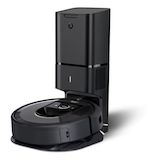 Buy Roomba i7+ from Amazon
Buy Roomba i7+ from Amazon 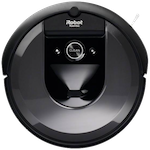 Buy Roomba i7 from Amazon
Buy Roomba i7 from Amazon B. Which Roomba Requires the Least Maintenance?
To evaluate the amount of maintenance required by each one of the 15 Roomba we have reviewed, we relied on a 4 step analysis summarized by Table 2 below. The criteria we have used are the following:
- Self-charging. A good Roomba should go back to its docking station and recharge once the cleaning cycle is over. This avoids you the hassle to worry about plugging and uplugging your Roomba to its charger.
- Dustbin capacity. With large homes, bigger dustbins are recommended. Otherwise, you’ll have to empty it frequently. Indeed, your Roomba will collect more dirt than you can expect, especially because it goes under furniture.
- Self-cleaning. Actually, this criterion decomposes into 2 sub-criteria. On the one hand there is the ability of the Roomba to clean itself. And on the hand, the provided dock should allow Roomba to actually clean itself.
Regarding self-charging all Roomba are good with this regard. Indeed, they are all shipped with a charging station. Besides, any Roomba is capable of finding its way back to its station, where it automatically docks.
Regarding dustbin capacity, the maximum is 650 ml (~22 oz). It is scored by Roomba 860, Roomba 880, and Roomba 890. The high-end Roomba 960 and Roomba 980 are close with 600 ml (~20 oz).
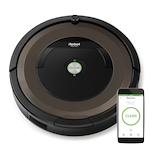 Buy Roomba 890 from Amazon
Buy Roomba 890 from Amazon The latest Roomba i7 and i7+ dustbin capacity is a disappointing 460 ml (~ 15.5 oz). But, this weakness is mitigated by their self-cleaning support. However, if both are capable of self-cleaning, only the Roomba i7+ is shipped with a Clean Base dock. So, only the Roomba i7+ can automatically empty its dustbin in a disposable bag included in its dock.
 Buy Roomba i7+ from Amazon
Buy Roomba i7+ from Amazon C. Which Roomba is the Easiest to Use?
To evaluate ease of use in the context of large homes, we have dissected 15 Roomba (see Table 3) with respect to the following criteria:
- Boundary Marking: This criterion evaluates how easy is it to mark boundaries that Roomba should not cross while cleaning. This is the way to tell Roomba rooms or spots it should avoid, such as your dog’s bowl.
- Selective Area Cleaning: This feature is the opposite of the previous one. It should be easy to tell Roomba to clean only a specific Room. For example if you expect friends for lunch, your Roomba should focus on the dining room.
- Scheduling: Best Roomba makes it easy for you to set a cleaning schedule. So, they will start cleaning on their own, at hours you have chosen. Best options allow not only to plan when Roomba should operate, but also which rooms, or zones it should clean.

Boundary Markers
The most common boundary markers for Roomba are so called Virtual Walls. These are small battery powered beacons that emit an infra-red light, just like any TV remote. We human, cannot see infra-red, but Roomba reacts to it. Actually, when Roomba receives the infra-red from a Virtual Wall beacon, it turns away, just like when it touches a wall.

Usually, Roomba are shipped with only 1 Virtual Wall. Some, such as the Roomba 780, the Roomba 880, and the high-end Roomba 980 come with 2 Virtual Walls. This is better, but often not enough for large homes. The best option is provided by the Roomba i7 and i7+. You can define as many boundaries as you wish on the smartphone companion app. No battery, no limitations.
Selective Area Cleaning
All 15 Roomba in this review do provide a hardwired spot cleaning mode. In this mode, Roomba moves following a spiral starting from its initial position (See Video 2). It eventually stops after cleaning an area about 3 feet wide (~1 m).
Video 2. Roomba Spot Cleaning Mode
The spot mode can only be activated manually. That is you have to be home, move Roomba to where you want it to clean, then press the spot cleaning button. This is useful in situations such as when your child accidentally spills breakfast cereals on the floor. Roomba will take care of the cleaning, while you make the lunch bag and ensure your daughter will be on time for school.

An automated version of spot mode is provided only by Roomba i7 and i7+. Based on your home map built by your robotic servant, you define on your smartphone custom zones, and decide when they should be cleaned. For example, you can schedule your Roomba to clean high traffic areas such as your kitchen, more often than other rooms. Your Roomba i7+ will automatically start at scheduled times, move to zones you have defined, clean them thoroughly before going back to its docking station.

 Buy Roomba i7+ from Amazon
Buy Roomba i7+ from Amazon  Buy Roomba i7 from Amazon
Buy Roomba i7 from Amazon D. Conclusion: Which Roomba is Best for Large Homes?
Time for overall scores of the different Roomba we have reviewed in this article. These scores obtained based on the 11 important features for large homes, presented above.
The first conclusion presented in Table 4 is that you should avoid cheapest Roomba. Indeed, none of the Roomba 600 series can cope with large areas.
Table 4. Cheap Roomba Cleaning Performance in Large Homes
The second observation is that most other Roomba grouped in Table 5 only do slightly better, compared to most affordable vacuum robots. However, Roomba 960 stands out. It scores 58% in our benchmark, which can be considered as almost good.
Table 5. Roomba 960 vs Cheaper Roomba in Large Homes
Among the 15 Roomba we have evaluated, only 3 achieve good to excellent performance cleaning large houses and apartments. Those are Roomba 980, Roomba i7 and Roomba i7+ which scores are presented in Table 6.
Table 6. Benchmark Results for 3 Best Roomba for Large Homes
Bottom line, the best Roomba for large homes is the Roomba i7+. It obtains an excellent score: 86%! This is the consequence of its many features including the unique self-cleaning dock. This is why the Roomba i7+ will really put your home cleaning on auto-pilot.
 Buy Roomba i7+ from Amazon
Buy Roomba i7+ from Amazon The Roomba i7 is the best value option. It has an excellent score in our benchmark (82%), all at an interesting price. Indeed, the i7 has almost all features of the i7+ except for automatic dirt disposal. But, choosing the i7 will save you $300! Besides, the Roomba i7 is ready for self-cleaning. So, you can buy the cleaning dock later.
 Buy Roomba i7 from Amazon
Buy Roomba i7 from Amazon The Roomba 980 has good performance. It has a higher score (63%) compared to Roomba 960 (58%), mainly because of its exceptional 120 min battery runtime. But, the Roomba 980 cost $300 more than the Roomba 960. The price difference does not worth it, since the Roomba 960 can recharge and resume cleaning.
 Buy Roomba 960 from Amazon
Buy Roomba 960 from Amazon  Buy Roomba 980 from Amazon
Buy Roomba 980 from Amazon Related
Leave a Reply Cancel reply
This site uses Akismet to reduce spam. Learn how your comment data is processed.




5 Comments